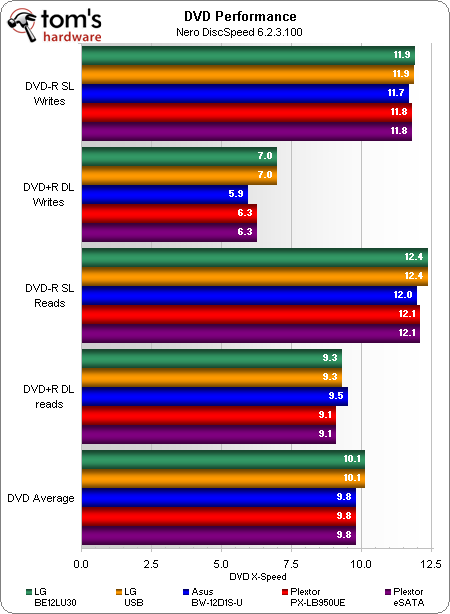Three External USB And eSATA Blu-ray Burners Tested
The advent of affordable, high-capacity media could bring a renaissance in optical storage, but only if the performance is adequate. We tested a few of today’s fastest drives with USB and eSATA connectivity to find out where this technology stands.
Picking The Best Burner
BD-R media has finally reached the performance and price points necessary to make it a practical storage medium. Far cheaper than flash drives and more portable than mechanical hard drives, the final question we need to answer is which drive to buy for this high-value media.
Today’s review focused on external drives for their broad compatibility, so any recommendations won’t apply to buyers who specifically want less-expensive internal hardware.
LG’s BE12LU30 leads when using eSATA, but falters under USB. Superb write speed for our legacy 4x media pushes the Asus BW-12D1S-U into second place, but its read speed is fairly bad.
Plextor’s PX-LB950UE wrote both the dual-layer and legacy BD-R media in a CLV pattern, even as the program we used reported CAV. The discs were still error-free, but average write speed suffered enough to drag the firm's implementation into third place.
LG tops DVD performance as well, with impressive dual-layer writes the biggest contributor towards that win.
Most readers would stop here and buy the LG, since it is the best performer. Indeed, we’d use it in our own desktops, were it an internal drive. Unfortunately, customers demand the utmost flexibility for external drives.
We checked all of our recent systems, including high-end notebooks, to see which interfaces we really needed. All of them supported either USB 3.0 or eSATA. Some supported both, and a few definitely did not have eSATA provisions. Since USB cripples LG’s performance, Plextor takes the lead in compatibility with our hardware. Yours might be different.
Get Tom's Hardware's best news and in-depth reviews, straight to your inbox.
Some of our other readers might be interested primarily in write performance, and for that we’d recommend Asus. An 8.6x write from cheap/old 4x media epitomizes our search for the best writing value, and the BS-12D1S-U even ties the other drives in writing newer formats.
While we have a clear performance leader, the choice isn’t so clear-cut for buyers. Asus is best for writing over USB, LG has the best overall performance when using eSATA, and Plextor is the only firm in today’s roundup to offer both interfaces.
Current page: Picking The Best Burner
Prev Page A Big Performance Surprise!-
Crashman pirateboyno LiteOn device? why?The eHBU212 wasn't available yet when this roundup was initiated last spring. Sorry, other reviews had deadlines.Reply -
Could you please add a chart about the quality of the burned data itself.Reply
(I do not know if this is possible?) A lot of people still burn audio CDs and for this the burn quality is normally essential -
Crashman Mille23Could you please add a chart about the quality of the burned data itself.(I do not know if this is possible?) A lot of people still burn audio CDs and for this the burn quality is normally essentialIt's in the photo album:Reply
http://www.tomshardware.com/gallery/bd-sl-scan-ASUS,0101-302721-9789-0-0-0-jpg-.html See no errors know no errors. -
Crashman dimarWhen do we finally get eSATAp?It's been replaced with USB 3.0, and neither of those has enough amperage to power these drives.Reply -
dimar CrashmanIt's been replaced with USB 3.0, and neither of those has enough amperage to power these drives.Reply
Not true. http://en.wikipedia.org/wiki/ESATAp
I already have the bracket for eSATAp where I have the power supply connected using the 12v/5v molex cable. -
Crashman dimarNot true. http://en.wikipedia.org/wiki/ESATApI already have the bracket for eSATAp where I have the power supply connected using the 12v/5v molex cable.That's fine, but it doesn't contradict what I said.Reply
Let me be more specific: USB 3.0 is primarily for portable devices, eSATA is primarily for stationary devices, and eSATAp is something in the middle that doesn't have enough power for "big" drives such as these.
The purpose of eSATAp WAS to combine the convenience of USB 2.0 with the performance of eSATA. But the purpose of USB 3.0 IS to combine the convenience of USB 2.0 with the performance of PCIe. This is a was vs is debate, Windows XP is still great too but many people have simply quit using it.
Hey, I remember external SCSI too!
BTW, some of these drives DO support eSATA. Forget the P, a USB power connector won't power these drives! -
dimar CrashmaneSATAp is something in the middle that doesn't have enough power for "big" drives such as these.Reply
You don't get it. You actually connect the power supply power cable to the back side of the eSATAp connector. It gets the full 12v and 5v load.


